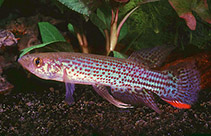| Family: |
Rivulidae (Rivulines), subfamily: Rivulinae |
| Max. size: |
12 cm TL (male/unsexed) |
| Environment: |
benthopelagic; freshwater, non-migratory |
| Distribution: |
South America: Araguaia River basin, Brazil. |
| Diagnosis: |
Dorsal soft rays (total): 10-14; Anal soft rays: 16-18. Distinguished from other species of the genus, except T. strigabundus, by having straight mouth cleft. Differs from T. strigabundus and all other species of the genus by the elongated pelvic fin of the males, whose tip is reaching to the base of 11th to 15th anal rays and the presence of a bright red stripe along the ventral margin of the male caudal fin. Seems to differ from T. strigabundus by having a larger size (Ref. 26656). |
| Biology: |
Bottom spawner, 8 months incubation (Ref. 27139). |
| IUCN Red List Status: |
Least Concern (LC); Date assessed: 07 November 2018 Ref. (130435)
|
| Threat to humans: |
harmless |
Source and more info: www.fishbase.org. For personal, classroom, and other internal use only. Not for publication.

